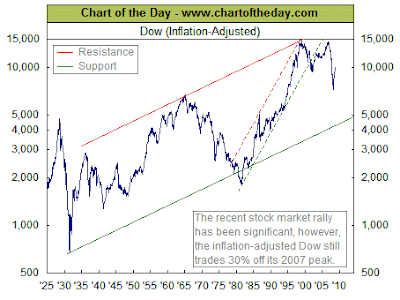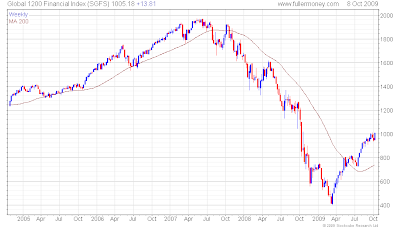M&B: The crisis that started in August 2007 is the abrupt adjustment to 20 years of over-indebtedness: over indebtedness by governments, individuals and corporations (to a lesser extent), thanks to central banks having provided plenty of liquidity, particularly in the US. Each time we had a crisis, the liquidity ticked up, and we had such crises more often over the past two decades and they became more acute and important in size. No decision was made to go to the root of these crises: over-liquidity leading to the misallocation of resources. Besides a loose monetary policy, these crises were also spurred by bad political decisions.
Is there anything new? No. The G20 in London focused on tax havens and in Pittsburgh on traders’ bonuses. Wrong, these are meaningless vis-à-vis the current crisis and its causes even if they do the front page of media and are talked up by politicians. These are pure scapegoats to deflect the attention of the public from the real roots of the problems and solutions that will be painful.
Regarding the banking industry, I do not believe that problems are healed. True, a collapse has been avoided and this is fine; we gained time, very important in troubled times. Many banks received public money, and many have repaid it. However so called toxic and non-performing assets are still in their balance sheets (or off balance sheets) and their value has
 not improved (home values not really increasing, credit card delinquencies on the rise, commercial real estate starting to hit, to name a few). Bank’s lending continues to go down, so the real economy is not getting the financing it needs, particularly small and medium businesses (loosing 50k jobs 10.000 small business is politically and journalistically irrelevant, loosing the 10k jobs via GM is important, this is the power of communication and making “events”).
not improved (home values not really increasing, credit card delinquencies on the rise, commercial real estate starting to hit, to name a few). Bank’s lending continues to go down, so the real economy is not getting the financing it needs, particularly small and medium businesses (loosing 50k jobs 10.000 small business is politically and journalistically irrelevant, loosing the 10k jobs via GM is important, this is the power of communication and making “events”).Many banks have returned to profits, but a lot has to do being financed at close to 0% whilst investing the proceeds in Treasuries yielding +/-3 % - a no brainer to make money by the way. The core business of banks (or what it should be) is not improving at all.
Look at Q3 results at JP Morgan Chase in details – one of the best managed banks. Net profit $ 3.6 billion: 7X Q3 2008 and +32 % / Q2 2009. Great! But hold on, look at the details. Over 50% are coming from investment banking (and over 2/3 of Investment banking revenues coming from trading profits). Retail financial services are hardly making any money ($ 7 million profits) and the situation is deteriorating compared to previous quarters with provision increasing (nearly $4 billion representing nearly 50% of net revenue). Card services losses are mounting: $ 700 million (close to $5 billion provisions) vs. a Q2 $ 672 million loss and a Q3 2008 $ 292 million profit (if I however do not dismiss the ability of the management to "overcharge" provisions to reduce the effective tax rate and create a cushion for the future and smooth results, in this case I believe the assessment is real). The rest of business lines is more or less flat.
And what about Goldman Sachs – the best fully-fledge investment bank – where 70% of its net revenues are derived from trading at $ 8.8 billion during Q3? Net common equity stand at more or less the value of level 3 assets (the illiquid difficult to value assets). From what I read, Goldman Sachs is also back to the happy days of leveraging (15X from my rough calculation of common equity/total assets - it is beyond the purpose of this interview, but I would be quite interested to know the ratio with off balance sheet items...). We are back to a Return on Equity (ROE) above 20%: I thought we were in a new world... Never mind, the tax payer bails out, and management retains their position with no financial sanction (the only one that really matters, besides jail).
A final word on commercial banks and subprime mortgages. A recent study published by the US FED showed subprime borrowers represented 20% of all new mortgages in 2006 to zoom down to zero in Q1 2008 to reach... 20% currently in an environment where net lending is negative for the first time since 1970.
All this led me not to be optimistic about the banking sector, bearing in mind that deleveraging will translate into lower ROE and lower valuations (just look at the collapse in private banking valuations that went from 6-8% of AUM some years ago to 1-3% now).
Sources:
Goldman Sachs
http://www2.goldmansachs.com/our-firm/press/press-releases/current/pdfs/2009-q3-earnings.pdf
JP Morgan Chase
http://investor.shareholder.com/jpmorganchase/press/releases.cfm?type=
Federal Reserve Bank of St Louis
https://research.stlouisfed.org/fred2/series/TOTLL?cid=100
Federal Reserve Bank of San Francisco
Economic Letter: Recent Developments in Mortgage Finance
http://www.frbsf.org/publications/economics/letter/2009/el2009-33.pdf
















